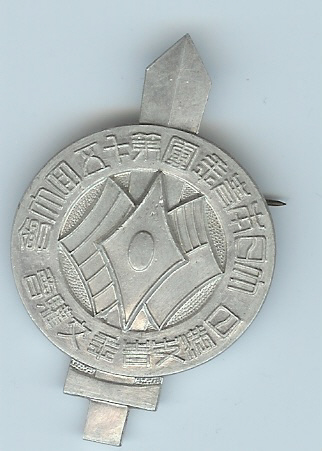Imperial Youth Federation on:
[Wikipedia]
[Google]
[Amazon]


 The , later known as the , was a nationalist youth organization in the Empire of Japan modeled after Nazi Germany's Hitler Youth.Sims. Japanese Political History Since the Meiji Renovation, 1868-2000, pp. 21
The , later known as the , was a nationalist youth organization in the Empire of Japan modeled after Nazi Germany's Hitler Youth.Sims. Japanese Political History Since the Meiji Renovation, 1868-2000, pp. 21
/ref>Abend. My Life in China 1926-1941. pp.274
/ref> It was active from 1937 until its dissolution in 1945.
/ref>


 The , later known as the , was a nationalist youth organization in the Empire of Japan modeled after Nazi Germany's Hitler Youth.Sims. Japanese Political History Since the Meiji Renovation, 1868-2000, pp. 21
The , later known as the , was a nationalist youth organization in the Empire of Japan modeled after Nazi Germany's Hitler Youth.Sims. Japanese Political History Since the Meiji Renovation, 1868-2000, pp. 21/ref>Abend. My Life in China 1926-1941. pp.274
/ref> It was active from 1937 until its dissolution in 1945.
History
The ''Dai-Nippon Seinento'' was a youth organization founded by ultranationalist activist ColonelKingoro Hashimoto
was a soldier in the Imperial Japanese Army and politician. He was famous for having twice tried to stage a coup against the civilian government in the 1930s.
Early career
Hashimoto was born in Okayama City, and a graduate of the 23rd class o ...
on October 17, 1937, following Hashimoto's temporary forced retirement from military service due to his involvement in the failed February 26
Events Pre-1600
*747 BC – According to Ptolemy, the epoch (origin) of the Nabonassar Era began at noon on this date. Historians use this to establish the modern BC chronology for dating historic events.
* 364 – Valentinian I is p ...
attempted coup d'etat against the government.
Hashimoto modeled the organization after the Hitler Youth of Nazi Germany, even to the extent of using a light brown color for member’s uniforms, and the adoption of a red banner with a white circle in the center as the party banner. The first party rally was held on the grounds of Meiji Shrine in downtown Tokyo, with approximately 600 members.
The stated aim of the party was to teach Japanese youth basic survival skills, first aid, life skills, cultural lessons, traditions and basic weapons training. However, Hashimoto's primary intent was to create an idealistic young cadre of supporters for the Imperial Way Faction
The ''Kōdōha'' or was a political faction in the Imperial Japanese Army active in the 1920s and 1930s. The ''Kōdōha'' sought to establish a military government that promoted totalitarian, militaristic and aggressive expansionistic ideals, ...
and its nationalist and militarist doctrines.
During the third party rally, held in Hibiya Park, Tokyo with some 2000 members in November 1939, Hashimoto expressed his support for the upcoming Tripartite Alliance with Nazi Germany and Fascist Italy
Fascism is a far-right, authoritarian, ultra-nationalist political ideology and movement,: "extreme militaristic nationalism, contempt for electoral democracy and political and cultural liberalism, a belief in natural social hierarchy and the ...
, and for a one-party system of government in Japan. He also set the ambitious goal of growing party membership to 100,000 members by the end of 1940.
However, with increased military conscription
Conscription (also called the draft in the United States) is the state-mandated enlistment of people in a national service, mainly a military service. Conscription dates back to antiquity and it continues in some countries to the present day un ...
due to the Second Sino-Japanese War and subsequently with the Pacific War
The Pacific War, sometimes called the Asia–Pacific War, was the theater of World War II that was fought in Asia, the Pacific Ocean, the Indian Ocean, and Oceania. It was geographically the largest theater of the war, including the vast ...
, most of his target age group was being drafted into the Japanese military, and the party fell far short of its goals. Although not specifically a “ political party” per se, the Great Japan Youth Party fell under the overall aegis of the Imperial Rule Assistance Association organized by Prime Minister Fumimaro Konoe
Prince was a Japanese politician and prime minister. During his tenure, he presided over the Japanese invasion of China in 1937 and the breakdown in relations with the United States, which ultimately culminated in Japan's entry into World W ...
from October 1940.
Unable to achieve his goals in Japan, and sidelined by actions of the government, Hashimoto returned to Manchukuo
Manchukuo, officially the State of Manchuria prior to 1934 and the Empire of (Great) Manchuria after 1934, was a puppet state of the Empire of Japan in Northeast China, Manchuria from 1932 until 1945. It was founded as a republic in 1932 afte ...
in late 1940, where he attempted to create another local youth organization similar to the Great Japan Youth Party among the Japanese settler population, with an equal lack of success.
By the end of World War II, the Great Japan Youth Party had devolved into little more than a defunct youth wing of the Imperial Rule Assistance Association, and was dissolved along with that organization by order of the American occupation authorities.Ando, Surrender, Occupation, and Private Property in International Law. pp. 170/ref>
See also
* Himeyuri Students *Tonarigumi
The was the smallest unit of the national mobilization program established by the Japanese government in World War II. It consisted of units consisting of 10-15 households organized for fire fighting, civil defense and internal security.
Histo ...
* Volunteer Fighting Corps
References
* * * *Notes
{{Authority control 1937 establishments in Japan 1945 disestablishments in Japan Defunct political parties in Japan Empire of Japan Far-right politics in Japan Japanese militarism Nationalist parties in Japan Political parties disestablished in 1945 Political parties established in 1937 Youth organizations based in Japan Youth organizations established in 1937 Fascist parties Youth wings of fascist parties